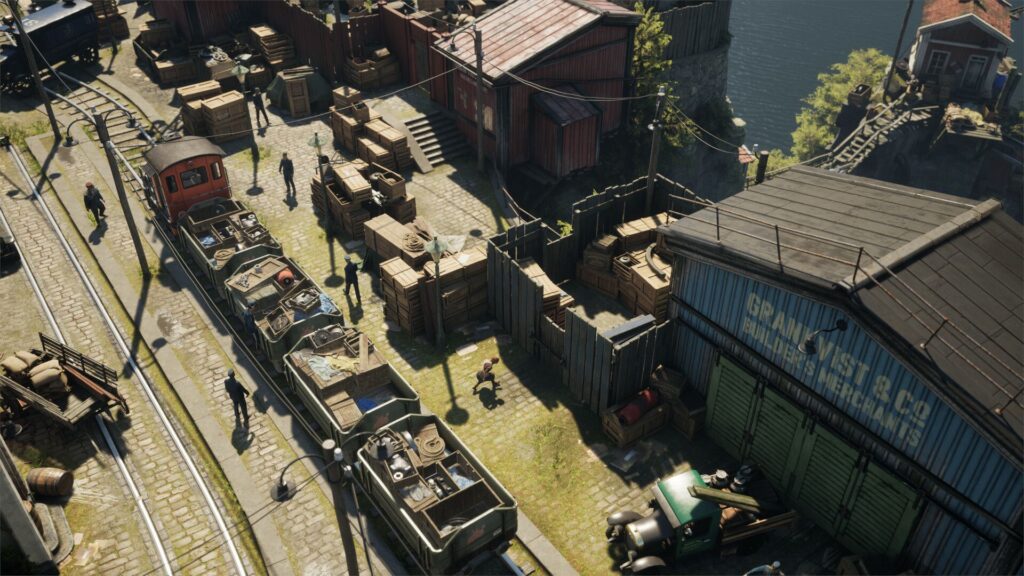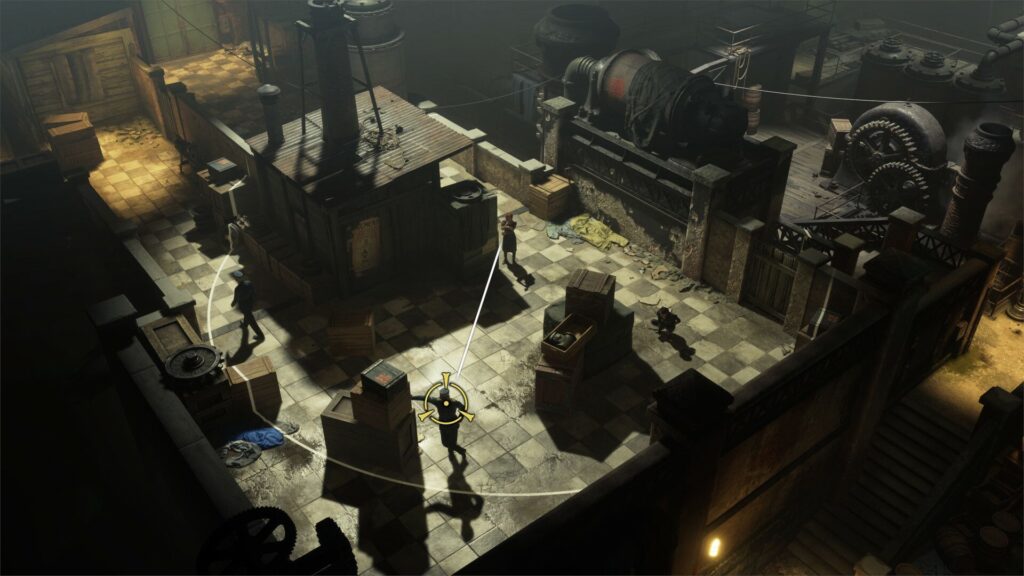Why Eriksholm: The Stolen Dream Could Be 2025’s Standout Stealth Experience
Stealth games are proliferated by special forces protagonists, stone-cold spies, and ninjas. Highly trained, powerful, emotionally stoic specialists in espionage. Their missions often centre on counter-terrorism, entrenching them behind enemy lines, in warzones, stalking mysterious countries via subterfuge. An arsenal of tactical gizmos usually in tow, these elite operatives out-manoeuvre their prey, remorselessly killing before retreating to the shadow’s sanctuary.
In Eriksholm: The Stolen Dream you are none of these things. You’re not a specialist agent of darkness; you are Hanna, a young woman driven to a life of escape and evasion in pursuit of her brother Hermann’s whereabouts, out-foxing her city’s police force who’re also on the hunt. Her skills? A back-of-her-hand knowledge of Scandi-like city Eriksholm’s layout, and a trusting relationship with its agnostic inhabitants. Her motivations? An emotional reconnection with her brother, and an attempt to reunite her family.
[embedded content]
In her effort to uncover the mystery surrounding Hermann’s disappearance, Hanna ignites a chain of events catastrophic enough to potentially derail her city’s destiny. As she peels back Eriksholm’s elegance she provokes forces darker than she ever imagined. Unravelling the eponymous city’s secrets lights a fire, a bright beacon casting long, dark shadows; sanctuaries in which she – much like stealth games’ typically elite operatives – can seek respite.
Eriksholm: The Stolen Dream is stealth cooked to a different recipe. Hanna isn’t cut out for combat, let alone killing. She’s brushed with authority before, but invariably she’s vulnerable. However, her intricate understanding of the city and its people is her greatest weapon, far more powerful than the incapacitating dart gun she acquires later during her quest. Skulking dimly lit alleyways, accessing subterranean networks, squeezing through tight spaces, she can reach points of interest and importance more efficiently than her pursuers.
The citizens she encounters behave naturally, greeting her with good grace, supporting her mission by offering direction through casual chat. Whilst Eriksholm: The Stolen Dream’s moment-to-moment gameplay resembles what you’ve learned to expect from the genre – observing patrol patterns, chucking noisy distracting objects, crouching in long grass, et cetera – it’s Hanna as it’s leading protagonist who sets the game apart.
Hanna isn’t the game’s only player controllable character though, her ally Alva also tags along – trailed by Sebastian much later on – with control freely switchable between all protagonists throughout. Each brings individual skills to the table too; Hanna crawls through vents, Alva climbs drain pipes, Sebastian can swim, and so on. The game’s environmental puzzles require players to use each of their party collaboratively in order to progress together. This design choice veers away from stealth titan Shadow Tactics: Blades of the Shogun’s multi-character approach whereby, as distinct as each operative was, any obstacles could usually be tackled solo; firing a cannon to blast a throughway previously inaccessible for their accomplice, for instance.
In devising Eriksholm: The Stolen Dream’s puzzles, the Gothenburg-based team at River End Games have taken a leaf out of fellow Swedes Hazelight Studios’ co-operative playbook whereby hurdles in Split Fiction, for example, are overcome through player-character collaboration; one can’t progress without working with their opposite number, combining their distinct skill sets simultaneously. Eriksholm offers single player comparisons, of course, but similar design ethoses all the same, situations where assessing environmental cues and obstacles in lieu of character skills encourages players to pick apart any given scene before deciding on its most optimal route.

River End Games’ Game Director Anders Hejdenberg describes Eriksholm: The Stolen Dream as a narrative-led, stealth-puzzle game, and it’s the game’s emphasis on story which drives many of the decisions taken during development by Hejdenberg to reinforce the title’s strong narrative beats.
The city of Eriksholm is inspired by turn-of-the-century Nordic cities. Having grown up and lived in Sweden, numerous of the seventeen-strong team at River End Games were aware of the region’s universal appeal so they worked hard to craft an environment which is both gorgeous and authentic, yet exaggerated by socio-economic and political strife. Each of the city’s districts is distinct, exuding culture, architecture, and social order that’re recognisably unique from one another.
Overall, its aesthetic borrows a little from Dishonored’s Dunwall with a little more from Disco Elysium’s Revachol, filtered through shades of dreamlike Studio Ghibli quality, most notably from Scandi-inspired Kiki’s Delivery Service. Much like Revachol of Disco Elysium, underlying Eriksholm is class conflict, with unrestrained industrialisation and capitalism’s looming annihilation further thematic integrations. Again, akin to Disco Elysium, Eriksholm: The Stolen Dream utilises its themes to provide multiple perspectives for the player to absorb and reflect on. The team have been very clear not to slip into cliché by defining rich suburbs as inhabited by evil doers, for example. Instead, the city’s atmosphere feels grounded in believable reality. As a platform intended for emotional storytelling, a city designed any other way simply wouldn’t be as effective.

It’s no surprise to learn that the city itself was the first stage of the game’s construction which River End Games focused on. An environment steeped in history yet on the precipice of a new age of technological opulence is a deeply interesting place to exist in. The game’s puzzles, its characters, patrolling enemies, and ambling pedestrians, all share the same beating heart. Narrative informs everything; everyone and everything has a story to tell.
Story-first implies Eriksholm: The Stolen Dream is a more tightly curated, linear-by-design experience, more so than any of its stealth action-adventure contemporaries. We see this in its Limbo and Inside-style instafail restarts. When a guard spots a character, for instance, the screen fades to black and the failure rewinds back to the encounter’s onset. Each encounter, as stated by Hejdenberg, is hand-crafted, with reactions from enemies and NPC behaviour alike tailored to specific situations. If the option was present for players to revert back to the shadows until a guard loses interest and returns to their post, then narrative propulsion would be lost.
It’s debatable whether this mechanic fosters enveloping stealth gameplay to its greatest potential, but going into Eriksholm: The Stolen Dream with the mindset this is a story to experience through the aesthetic of stealth should help alleviate any immersion-breaking concerns. Furthermore, puzzles’ solutions are frequently telegraphed to players via diegetic means, for instance: enemy dialogue could clue you into the fact a guard is afraid of birds, so maybe, you’d think, disrupting a flock resting nearby could provide effective distraction. ‘Aha’ moments such as this broaden linear design’s sometimes penned in nature. The guard afraid of birds could probably still be incapacitated by a dart, but contextual solutions integrated into the environment ensures player agency isn’t lost. Eriksholm isn’t a sandbox. However, choice in how to solve problems whilst experiencing an engrossing story that chugs along at a hand-crafted pace is an enticing prospect, and one which should make Eriksholm: The Stolen Dream the stealth game to look forward to.
Its isometric viewpoint might give the impression Eriksholm: The Stolen Dream is closely aligned to Commandos, Desperados, or the aforementioned Shadow Tactics, but this is in perspective only. This debut title from River End Games is more akin to emotionally charged narrative-led games like A Plague Tale (Eriksholm’s inhabitants even suffer under the cloud of a debilitating disease dubbed Heartpox) but with novel stealth-based gameplay providing a vehicle in which to mobilise its story.
Note: The views expressed in this article are those of the author and do not necessarily represent the views of, and should not be attributed to, GamingBolt as an organization.


Comments are closed.